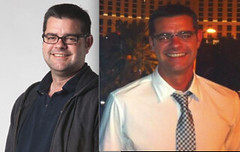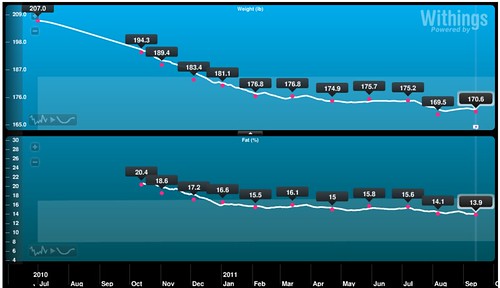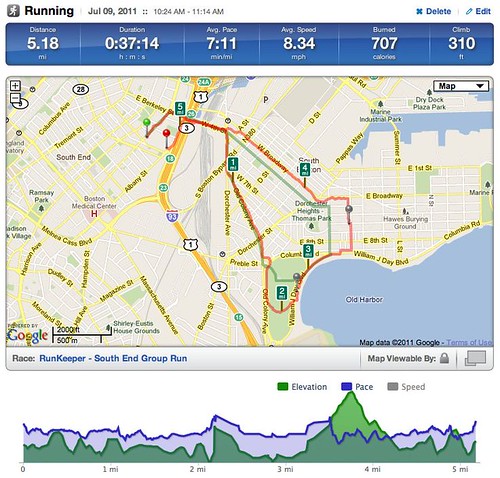A few days ago, I celebrated my birthday and was pinged on Facebook by friends and family congratulating me on being another year older (!).
Along with those good wishes, I also got a few virtual pats on the back, commenting on how healthy I was looking in some recent photos and asked for details on how I achieved the progress I had made. Of course, it's awesome for people to take notice of the hard work you've put in and confess to blushing a little at the complements. This post is my response, sharing some of the things that have worked for me in the last 14 months or so in my journey to make a better me.
Before I start, I want to stress: the following worked (and is working) for me. It's not meant as a prescription or a recipe for you. It is a bunch of things - given my psyche, environment and genetics - that worked for me. If you're looking to go on a similar journey (or already on your journey and looking for new ideas), feel free to take a little of "this", and a bit of "that", and plenty of none of "this"! So let's go to it...
It's about making a decision and sticking to it.
A few weeks ago I was at Boston Logan airport checking in when the the lady processing my boarding pass did a double take when she looked at my Mass driver's ID. She commented that I looked a lot different to the photo on the card. She asked how I lost all that weight. I told her that I made a decision a while ago and had stuck with it. She congratulated me warmly and gave me back my ID.

(12 months - before and after not my actual ID pics!)
In July of last year I made that decision. I was unhappy (and felt guilty) about my general level of fitness, I didn't like what I saw in the mirror and was feeling increasingly physically uncomfortable. And no surprise...at that time I weighed 204 lbs (I'm 6ft), with an estimated body fat: of ~24%. I was doing no regular exercise and was on course to add another 5-10 lbs over the next year. Not good, at all.
So I decided to change that. My goal (I'll come back to this later) was high-level. Maybe a little too high-level. It was to "Lose weight!". I didn't specify how much or in what time period, all I knew is that I wanted to reverse the trend, and given where I was I felt that was good enough. All the progress and achievements stem from that decision and deciding to stick with it.
It has to be sustainable.
I started slow. I thought about my goal in terms of two dimensions - 1. how much + what I was eating and 2. how much + the kind of exercise I was doing.

On the food side, I stopped eating junk and started eating more "whole foods": unprocessed foods like salads, meats that hadn't been gunked with preservatives and crap, fruit not candy, etc. I wasn't measuring calories but I stopped snacking.
On the exercise side, I wanted to actually do some but not over-do it too quickly. My body was badly out of condition and I did not want to injure myself and go two steps backward. So I started doing long walks and bought a cycling machine - 30 mins of walks + 20 mins of gentle cycling to start. Every day. Nothing dramatic.
I did that for about a month and was already feeling the benefits. I probably lost about 5 lbs in that time. As I progressed, my resolve hardened. But I also realized that I wanted the good things in life too - to drink when I like and not give up delicious food. The trick was to find the right balance between the input (caloric intake) and the output (energy consumed) and to achieve a daily caloric deficit. Depriving myself of the things I enjoy (good food and drink) wasn't going to be a sustainable path to success.
Psychologically, this sustainable path for the long term has been a core component to my being able to stick with the decision I made. For me, it was all about finding that right balance and since I made that decision, I've been able to eat delicious food that fills me and drink what I want when I want. But that has also meant doing the exercise required to balance it out.
"If you don't measure it, you can't manage it".

(My Withings charts - shows body weight in lbs in top half, body fat % lower half)
By that point I got more specific with my goals. I researched the question of how much I should weigh in order to get out of the "overweight" zone and into the good zone. The answer came back - with my natural physique, I needed to get to around 175lbs, and lose a further ~20 lbs to be at my ideal weight. I also started learning more about body fat % (BF). I didn't know what my number was (I could estimate it roughly using some online calculators) and realized that my BF%, along with my weight, was something I wanted to measure and track.
I ordered a Withings scale from Amazon - a pretty cool wi-fi enabled device that comes along with a web service and iPhone app where you can track graph the numbers, including BF%. Since then, It has acted as an invaluable tool on my journey: being able to track and review my weight and BF history and overall progress has helped the psychological re-enforcement that comes from having the "proof" and details of my progress. It helps to remind me about how far I've come, where I want to get to and how much I really don't want to go back to where I was. It remains a concrete expression of the output of my decision.
Don't go it alone.

Throughout my journey I tried to learn as much as I could about being effective in my efforts. There's a ton of websites and resources out there that I came across - lots of good advice and tons of bad ideas. One resource that help me a lot was the Reddit.com fitness subreddit - I was (and still am) mainly a lurker there, occasionally asking questions and generally getting sound advice from a community of smart people who know their stuff. As long as you've already looked through the FAQ, it is a safe place to ask "dumb" questions as well as discussing more advanced topics.
The other big help was having a friend who is also on their own journey. I don't think it really matter what level they happen to be at - the main thing is that you're able to share your own progress, goals, tips, tricks etc and learn from each other. It also helped my motivation. I've had one since the beginning and I know this helped lot.

(Runkeeper global meetup - Boston, July 2011)
Define a destination. Set and reset goals.
Generally speaking, I think anyone who aims to acheive anything needs to figure out 2 things: 1. define the destination (the end-goal or objective) and 2. plot the waypoints to that destination (the mini-goals and a strategy to get there).

My goals evolved over time. When I set out on my journey, I had a general, non-specific goal. That was fine to start off with, but as I progressed and started measuring progress I began to get more specific. I went from "Lose weight!" (very high-level) to my current goal with several in between. You could even say that my current end-goal definition (or destination) is really a mission:
to be fitter today than when I was 20 years old.
For me, that's a durable mission and one that motivates me to keep on right track over the long-haul.
Then there's the question on how I get there. I started getting more specific with my mini-goals: to lose x lbs (but not timeframed), achieve x BF%, cover Y distance on the bike in y minutes, run x miles in Y minutes, lift X weight for Y reps for Z sets. I happen to be very goals-driven, it's how I'm wired. I need that sense driving toward a destination and the satisfaction of achieving my goals. And back to the measuring bit, I used tools like Runkeeper, the Withings scale, Fitocracy and MyFitnessPal to track (and in some cases share) progress across my activities as well as (more recently) tracking food intake.
My regime
Now, on to the details of my "regime". Please remember - the following isn't meant as a prescription or recipe: I'm sharing this because a number of friends have asked for the specifics, so I'm sharing what has worked (is working) for me.
The main principles behind my regime design are:
- Get strong. Apart from the aesthetic benefits of having muscle and lower body fat %, the fact is the more muscle you have, the more calories you burn through - and not just while actually doing the exercise. So the muscle I'm building and the exercise I'm doing to build that muscle (and the subsequent metabolic effect the lifting has on the central nervous system) allows me to eat well (back to the "sustainable lifestyle" point above). When I set out on this journey I never thought I'd find myself going to a gym and "lifting weights". But that's the essential part of what I've been doing for a over a year now.
- Resource tip: I picked up an awesome book and program called Starting Strength. It's a beginner's guide on how to correctly and safely lift weights (the 5: squat, press, bench press, deadlift, and power clean) and does a great job of explaining the "why" and benefits of strength training using these lifts as the core exercises of any fitness program.
- Keep getting stronger. As per the Starting Strength program, I'm always aiming to lift more (adding weight) and harder. Apart from the psychological benefits provided by the sense of progression, there are also physiological benefits to stressing (but not over-stressing) the body each session. In other words, I'm not going to the gym to have a "walk in the park". Keep making the body adapt.
- Run without dying - this is referring to my overall cardiovascular fitness. So I run regularly or do other exercise that keeps my heart rate up for more than 20 mins at a time.
- Keep it interesting - variety is the spice of life as they say. Getting bored doing the same exercises over and over can threaten the enjoyment of the journey. So I mix it up (the "Ancillary" work that helps with constant adaption), different runs with different goals, basketball not jogging, but I always stick with my "core" work: squat, deadlifts, benches, chins, pullups and dips.
- Eat well, but smart - on the food side, I want to be able to eat and drink what I want, when I want - within reason. I've completely cut out junk food (except for very rare occasions), and drink spirits or wine but not beer. In the early days I was particularly careful around carbs (I wasn't doing weight training then), but have since learned not to be fearful of them (in fact, I've come to realize that "carbs" - especially starchy carbs - are essential to muscle development and body recovery. I've recently been experimenting with the Leangains system, following the early morning training protocol with very positive results. This may be a program I'll cycle in and out of weeks at a time (2 weeks on, 4 weeks off or something)...we'll see.
- Respect the rest - I rarely do heavy lifting excercise 2 days on a row. I alternate workout and rest days (one day on, next day off). Without proper recovery you're wasting the time you put into the workouts. I have a week off every 5-7 weeks and generally speaking try to get more sleep than I used to.
So, with that rather extended preamble(!), here are the specifics of what a typical week might look like:
***Pull Day (Monday)***
-- Core
- Squats - warm ups: 10 reps no bar, 10 reps just the bar, 5 reps at 50% RM, 5 reps at 70%
- Squats - workout sets: 3 sets of 5 reps at 85% RM
- Deadlifts - warm ups: 10 reps just the bar, 5 reps at 50% RM, 3 reps at 70%
- Deadlifts - workout set: 5 reps at 90% RM
- Weighted Chins: 3 sets of 6-8 reps
- Weighted Pull-ups: 3 sets of 6-8 reps
-- Ancillary
- Ab work: e.g. weighted incline bench: 3 sets of 8-10 reps
- Rows work: - e.g. seated rows or weighted inverted rows: 3 sets of 8-10 reps
- Leg curls: 3 sets of 6-8 reps
Eat +20% of calorie maintenance
***Rest Day (Tuesday)***
Eat -20% of calorie maintenance
***Push Day (Wednesday)***
-- Core
- Squats - warm ups: 10 reps no bar, 10 reps just the bar, 5 reps at 50% RM, 5 reps at 70%
- Squats - workout sets: 3 sets of 5 reps at 85% RM
- Bench press - warm ups: 10 reps just the bar, 8 reps at 50% RM, 5 reps at 70%
- Bench press - workout sets: 3 sets of 5 reps at 85% RM
- Weighted dips: 3 sets of 6-8 reps
-- Ancillary
- Dumbbell work
- Tricep work
- Leg extensions: 3 sets of 6-8 reps
***Rest Day or Cardio Day (Thursday)***
20 - 45 min run, or a CrossFit type work out without heavy lifting (i.e. a cardio-centric workout for 15 to 20 mins).
***Pull Day (Friday) - as above***
***Rest Day or Cardio Day (Saturday) - as above***
***Pull Day (Sunday) - as above***
A few definitions:
- Rep = a single repetition
- Set = a set of reps
- RM = Repetition Maximum (the maximum you can lift something once) - see Predicting One Rep Max.-
Tools and resources
So there you have it. Let me know if you have any questions or even tips that have worked for you!